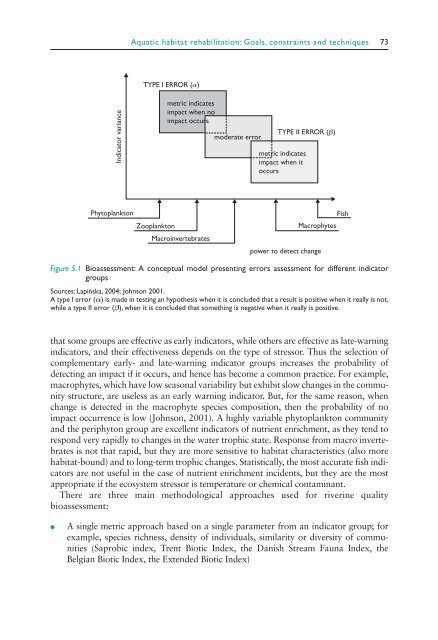Aquatic Habitats In Sustainable Urban Water Management
Aquatic Habitats In Sustainable Urban Water Management
Aquatic Habitats In Sustainable Urban Water Management
- No tags were found...
Create successful ePaper yourself
Turn your PDF publications into a flip-book with our unique Google optimized e-Paper software.
<strong>Aquatic</strong> habitat rehabilitation: Goals, constraints and techniques 73<br />
TYPE I ERROR (a)<br />
<strong>In</strong>dicator variance<br />
metric indicates<br />
impact when no<br />
impact occurs<br />
moderate error<br />
TYPE II ERROR (b)<br />
metric indicates<br />
impact when it<br />
occurs<br />
Phytoplankton<br />
Zooplankton<br />
Macroinvertebrates<br />
Macrophytes<br />
power to detect change<br />
Fish<br />
Figure 5.1 Bioassessment: A conceptual model presenting errors assessment for different indicator<br />
groups<br />
Sources: Lapińska, 2004; Johnson 2001.<br />
A type I error (α) is made in testing an hypothesis when it is concluded that a result is positive when it really is not,<br />
while a type II error (β), when it is concluded that something is negative when it really is positive.<br />
that some groups are effective as early indicators, while others are effective as late-warning<br />
indicators, and their effectiveness depends on the type of stressor. Thus the selection of<br />
complementary early- and late-warning indicator groups increases the probability of<br />
detecting an impact if it occurs, and hence has become a common practice. For example,<br />
macrophytes, which have low seasonal variability but exhibit slow changes in the community<br />
structure, are useless as an early warning indicator. But, for the same reason, when<br />
change is detected in the macrophyte species composition, then the probability of no<br />
impact occurrence is low (Johnson, 2001). A highly variable phytoplankton community<br />
and the periphyton group are excellent indicators of nutrient enrichment, as they tend to<br />
respond very rapidly to changes in the water trophic state. Response from macro invertebrates<br />
is not that rapid, but they are more sensitive to habitat characteristics (also more<br />
habitat-bound) and to long-term trophic changes. Statistically, the most accurate fish indicators<br />
are not useful in the case of nutrient enrichment incidents, but they are the most<br />
appropriate if the ecosystem stressor is temperature or chemical contaminant.<br />
There are three main methodological approaches used for riverine quality<br />
bioassessment:<br />
●<br />
A single metric approach based on a single parameter from an indicator group; for<br />
example, species richness, density of individuals, similarity or diversity of communities<br />
(Saprobic index, Trent Biotic <strong>In</strong>dex, the Danish Stream Fauna <strong>In</strong>dex, the<br />
Belgian Biotic <strong>In</strong>dex, the Extended Biotic <strong>In</strong>dex)















